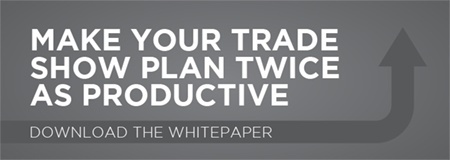With your 2016 marketing budgets being scrutinized, the importance of maximizing the return on your trade show investment is more important than ever. Trade show expense is the number two advertising expense for many companies, so you want to know how to get the most bang for your exhibiting buck. Start with understanding that some leads might NOT be a good fit for you and while you are in your trade show booth - focus on seeing these signs:
 1) They don't have the budget.
1) They don't have the budget.
If a lead simply doesn't have the budget for your product or service, there's really not much you can do to save the situation. Trouble is, determine a lead's financial standing before you pass them on to your sales team is sort of a double-edged sword. If you ask too soon, you run the risk of scaring them away. However, if you don't ask at all, your sales team might end up wasting time trying to pry this information from them.
What's a marketer to do?
We recommend sitting down with your sales team to discuss the importance of this qualifying criteria. Depending on your business, you may find that it's entirely okay to wait until the lead gets on the phone with a sales rep before budget becomes a factor. If not, it's important that you're extremely careful in your information collection approach.
Rather than blatantly asking for budget insight on the first form a visitor fills out, save this question for a bottom-of-the-funnel form. This will help ensure that your lead has had a chance to engage with some of your content and is beginning to establish a sense of trust. If and when you do include this field on a form, consider using a drop-down of choices that provide a range rather than an exact amount. This positioning is less invasive and aims to avoid pigeonholing a lead based on financials when there could be an opportunity for your sales rep to negotiate.
2) They don't have the power to make decisions.
What's their job title? While a new hire at company XYZ may have been interested in that ebook your business published last month, that doesn't mean they're in a position to call up budget and actually purchase your product or service. Even their boss' boss might not have the authority to call the shots. Then what?
To help set your sales reps on the right path, you want to connect them with actual decision makers like senior executives or someone who works directly with the company's c-suite. If you find that you're having a hard time attracting these types of people, you may want to reevaluate your marketing strategy to better align with their wants and needs as content consumers. Maybe you try creating more snackable content that lends itself to their relentless schedules, or refocus your distribution efforts to focus on more professional platforms like LinkedIn.
3) They don't have a need for your product or service.
Do you have a rough concept of what this lead is looking to accomplish? Why are they seeking your solution in the first place?
There are a number of things that could signal that a lead doesn't have a need for your product or service. Maybe they've expressed that they aren't experiencing the challenges in which your product or service solves for. Or perhaps they've noted that they are already using a vendor that offers what you do and don't have intentions of switching. Probably not worth your time, right?
At HubSpot, we use our top-of-the-funnel landing page form as an opportunity to get to know our visitors better. This includes asking them about their biggest marketing or sales challenge. While this isn't a required form field, it does present our visitors with a chance to explain what they're currently struggling with to give us a better sense of if and how we can help.
4) Their company is too big / too small for your solution.
For many businesses, company size can make or break the quality of a lead. Maybe your solution is designed for SMBs, yet you seem to be attracting a lot of enterprise leads. While enterprise leads often have more budget to allocate, you simply can't sell what you can't support, right?
To simplify the way you size up your leads, ask how big they are upfront. This is an easy -- and often expected -- question to ask on a form. In doing so, it'll be much easier to distinguish workable leads from ones that your solution can't do much for.
Keep in mind that this doesn't mean you need to throw these leads away and never look back. If you have plans to expand your product or service to meet the needs of all different sized businesses, you can revisit this list when you're ready.
5) They're located outside of your selling territory.
The beautiful thing about the internet is that it makes it easy for people all over the world to come across our business' websites. It's likely that you'll have leads coming in from far and wide. While it's exciting to see your reach growing, not all locations are going to be a fit for your company.
Depending on what you're selling, you might have some geographic restrictions that prevent you from doing business with people or businesses in certain territories. Passing those outliers off to your sales reps won't do them much good, which is why it's important to keep an eye out for where your leads are coming from.
If your business is interested in global leads, keep in mind that you can move them closer to a sale by creating tailored experiences for different locations. If you're a HubSpot customer,Smart Content will enable you to alter the content displayed on any given page based on the person's location. The best part? They don't even have to be a lead yet for it work.
6) They're not engaging with your content.
In a perfect world, leads would open every single lead nurturing email that came their way. They'd be flocking to our last blog articles and offers, waiting on any and every opportunity to tweet a quote.
While it's our job as marketers to leverage content to move leads further down the funnel, some efforts are bound to be more receptive than others. Your leads' engagement -- or lack thereof -- often serves as a strong indicator of whether or not they're going to be a good fit for your product or service.
In other words, if you find that your emails are going unopened and your links aren't getting clicked, it's likely that they aren't ready to take next steps. But if they continue to pick up what you're putting down, they'll probably be more willing to get on the phone.
Our advice? Prioritize the most engaged leads first, and save the unresponsive ones for a reengagement campaign in the future.
7) They used fake contact information.
Did your lead listed their number as 555-5555? Do they really expect you to believe the best email address to reach them at is 12345@aol.com?
Let's face it ... they're just not that into you.
When a visitor uses fake contact information to covert into a lead, it signals that they aren't really interested in connecting with a member of your team. This isn't to say they aren't evergoing to be interested, but false information isn't going to get you very far in the here and now, right?
When (and if) they are ready, they'll give up the real stuff. For now, let misinformation serve as a red flag for leads who simply aren't a good fit.
Guest Blogger - Carly Stec - http://blog.hubspot.com/sales/author/carly-stec






